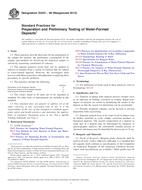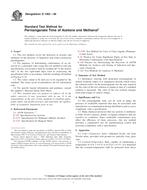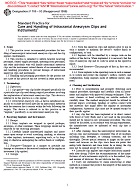1.1 This practice is limited to the method of conducting an evaluation of a nonmetallic material’s microbiological susceptibility when in contact with the natural environment of the soil. This practice is intended for use on solid material test specimens that are no larger than approximately 2 cm (¾ in.) thick and 100 cm2 (20 in.²) or on film forming materials such as coatings which may be tested in the form of films at least 50 by 50 mm (2 by 2 in.) in size. This practice may be applied to articles that do not spend the majority of their service life in soil.
1.2 A wide variety of properties may be affected by microbial attack depending on material or item characteristics. Standard methods (where available) should be used for each different property to be evaluated. This practice does not attempt to enumerate all of the possible properties of interest nor specify the most appropriate test for those properties. Test methods must, however, be appropriate to the material being tested.
1.3 It is recommended that this practice be combined with appropriate environmental exposures (for example, sunlight simulating weathering devices, the hydrolytic effects of extended aqueous contact, or extraneous nutrients) or fabrication into articles (for example, adhesive bonding of seams) which may promote microbiological susceptibility during the service life of the material.
1.4 The values stated in SI units are to be regarded as standard. The values given in parentheses are provided for information purposes only.
1.5 This standard does not purport to address all of the safety concerns, if any, associated with its use. It is the responsibility of the user of this standard to establish appropriate safety and health practices and determine the applicability of regulatory limitations prior to use.
Product Details
- Published:
- 06/01/2009
- Number of Pages:
- 3
- File Size:
- 1 file , 64 KB
- Redline File Size:
- 2 files , 120 KB


